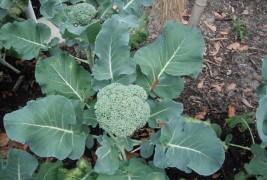Happy New Year, 2013.
Good news is not always easy to find in America’s Industrial food system. Recent articles highlighted in Ecology Florida News have focused on the relative scarcity of local farmers’ markets and CSAs in the state, knotty issues associated with GMOs, and a critique of the dominance of our food culture by Big Agriculture. Watch for our upcoming feature article on the GMO debate.
Of course, these are just a few topics relevant to the ecological dimensions of food production, delivery, sale, and consumption. From our standpoint, food is a major indicator of the relationship between ecologies of culture, economics, and nature – and the health of all three. Would that there was more good news to report about food and the three ecologies.
One bright spot on the food front is the good news that local megastores and major grocery chains are beginning to carry organic foods. Organics have been a growing sector in the grocery industry, and it is spurring expansion of organic farming enterprises, offering consumers healthy alternatives to manufactured food, and most likely contributing to better health.
While this decision by boards and marketers of major retail food corporations is indeed a bright spot, there is cause to pause, however, and consider sources for some mass-market organic foods. Because Florida is such a prolific fruit and vegetable producer, the organic produce sections major food retailers should be of special interest to residents of our state – they certainly are to Ecology Florida.
A tour of local markets in the first week of the new year revealed a wide selection of organic broccoli and cauliflower in the “Green” section of a major regional grocery chain. There were well over a dozen heads of each (and surely more in the produce cooler). What was notable about these two nicely displayed, plastic-wrapped winter vegetables was their cost ($4.99 per head) and their origin — California. The broccoli was from San Juan Bautista (2345 air miles/2800 ground miles from Tampa) and the cauliflower was from Salinas (2352 air/2829 ground miles from Tampa). There was also plenty of non-organic broccoli and cauliflower, which was considerably less expensive, although the cauliflower was from California. Fortunately, at least the broccoli was from Florida, although it was still grown almost 200 miles from its point of sale.
That 200 mile journey for the non-organic broccoli was the exception. Aside from Kumquats from Dade City, there was nothing in the produce section grown locally (within 100 miles). Like the organic items from California and other states (and nations), staggering food-miles were the norm. More often than not, the food-miles for items at corporate grocers and mega stores exceeded the current average of 1,500 miles per food item consumed in the USA – especially for organics. (see http://www.worldwatch.org/node/827)
Adjacent to the organic section was the citrus aisle. Natural logic suggests we should do better there. This is Florida, after all. We even have citrus images printed on our license plates. But the logic of the industrial food system (from industrial farm to mass-market retail centers, to your table) is not a natural logic or the logic of nature. It is the logic of a food economy granted the incredible grace of being able to function with disregard for ecological consequences and disinterest in sustainability. It is the logic of a consumer-based economic system.
The incredible grace allowing our industrial food system to flourish despite its harm to nature and culture came not from a Divine Power but from us. We granted this grace by privileging cheap over good, fast over healthy, and convenience over care. The process began on a massive scale in the latter half of the 20th century – and we have been paying for it ever since.
So, by this strange logic and incredible grace, in citrus sections of Florida grocery stores in January, it is not surprising to find Clementines from Spain and oranges from California. The Clementines travel over 4,000 miles and the oranges over 2,000 to reach our state — which is by far the largest citrus producing state in the nation.
This January, like others before it, there is no need to buy citrus from anywhere other than Florida. The crop is coming in all over the state, with wide ranging varieties of Grapefruit, Oranges, Kumquats, Lemons, Pomelos, Tangerines, Limes, and more. There is plenty available – and the stores do carry Florida citrus – although they promote the fruit from California and Spain. Opting for the local citrus is better for the planet – to say nothing of the state. It is also better for the three ecologies that sustain us – natural, cultural, and economic.
Friends, this is winter growing season in Florida, and we should be able to have good supplies of every winter vegetable that grows, especially organic broccoli and cauliflower. You can find those products here in Florida, probably nearer than you think, for much less than $4.99 a head, and virtually no “food miles.” Find a local market, join a Co-Op, take a share in a CSA. Organic broccoli, cauliflower, cabbage, kale, and other winter greens are being harvested around the state right now; and organic citrus is even more abundant. Florida is food paradise, if we will only recognize it. An organic urban gardener produced cauliflower heads weighing between three and four pounds, and another harvested 50 heads of broccoli from a front-yard garden.
We can do better than shrink-wrapped industrially-produced organic broccoli, flown across the full width of North America, and sold for $4.99 a head in a state where just about anyone with few feet of soil or a couple of 10 gallon pots can grow plenty of broccoli, and a hobby farmer can produce over 200 heads with little effort on a tiny urban plot.
We can do better than Clementines from Spain and oranges from California in a state producing more oranges than the rest of the nation combined.
We can do better right now when we shop for our food – and we can do ever better in the coming year. Wendell Berry reminds us: “We can have agriculture only within nature, and culture only within agriculture. At certain critical points these systems have to conform with one another or destroy one another.” We are lifting a New Year’s toast to the conforming of these systems. Happy New Year, 2013.
Sources
World Watch, “Paper #163: Home Grown: The Case For Local Food In A Global Market. http://www.worldwatch.org/node/827
USDA, “Background Statistics: US Citrus Market.” http://webarchives.cdlib.org/sw1bc3ts3z/http://ers.usda.gov/News/citruscoverage.htm
USDA, “Citrus Production by Type and State – United States.” /tmp/PreviewPasteboardItems/cit0612-10 (dragged) 1.pdf


Leave a Reply